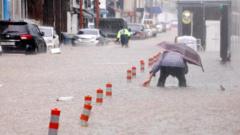As torrential rains wreak havoc across South Korea, the government has elevated its disaster alert to the maximum level following the tragic deaths of four individuals and the evacuation of more than 1,300 people. The unseasonal downpour is expected to persist, raising concerns about further casualties and property damage.
The fatalities highlight the dangerous conditions—two men in their 80s lost their lives, one reportedly while attempting to remove floodwaters from his basement. Another victim succumbed to injuries from a wall collapse, which occurred moments after he warned his wife that his vehicle was being swept away. The fourth individual suffered a fatal cardiac arrest amid the turmoil.
Residents have shared harrowing accounts of the flooding. In Gwangju, café owner Kim Ha-min described the unprecedented situation stating, “I couldn’t understand how something like this could happen.” The city received 426mm of rain within a single day, compelling Kim to halt operations due to severe flooding that affected her establishment.
Authorities in the worst-hit area, Seosan, reported an astounding 400mm of precipitation in just half a day—a phenomenon the weather agency classified as a "once-in-a-century event." As floodwaters engulf entire neighborhoods, residents have taken to social media to express their shock, with one person lamenting, “Everything is covered by water except the roof of my house.”
In total, injuries have been reported across South Korea, with some individuals suffering from hypothermia due to soaked conditions. Rescue operations continue, with officials advising communities to remain vigilant against potential landslides and flash floods. According to the meteorological agency, the extreme rainfall has been caused by the collision of dry air from the northwest and moist, warm air from the south.
Despite the immediate threat, forecasters anticipate a return to hot weather patterns next week, raising concerns about a potential heatwave after the current floods subside. The situation remains dynamic as authorities strive to manage the unfolding crisis.
The fatalities highlight the dangerous conditions—two men in their 80s lost their lives, one reportedly while attempting to remove floodwaters from his basement. Another victim succumbed to injuries from a wall collapse, which occurred moments after he warned his wife that his vehicle was being swept away. The fourth individual suffered a fatal cardiac arrest amid the turmoil.
Residents have shared harrowing accounts of the flooding. In Gwangju, café owner Kim Ha-min described the unprecedented situation stating, “I couldn’t understand how something like this could happen.” The city received 426mm of rain within a single day, compelling Kim to halt operations due to severe flooding that affected her establishment.
Authorities in the worst-hit area, Seosan, reported an astounding 400mm of precipitation in just half a day—a phenomenon the weather agency classified as a "once-in-a-century event." As floodwaters engulf entire neighborhoods, residents have taken to social media to express their shock, with one person lamenting, “Everything is covered by water except the roof of my house.”
In total, injuries have been reported across South Korea, with some individuals suffering from hypothermia due to soaked conditions. Rescue operations continue, with officials advising communities to remain vigilant against potential landslides and flash floods. According to the meteorological agency, the extreme rainfall has been caused by the collision of dry air from the northwest and moist, warm air from the south.
Despite the immediate threat, forecasters anticipate a return to hot weather patterns next week, raising concerns about a potential heatwave after the current floods subside. The situation remains dynamic as authorities strive to manage the unfolding crisis.




















